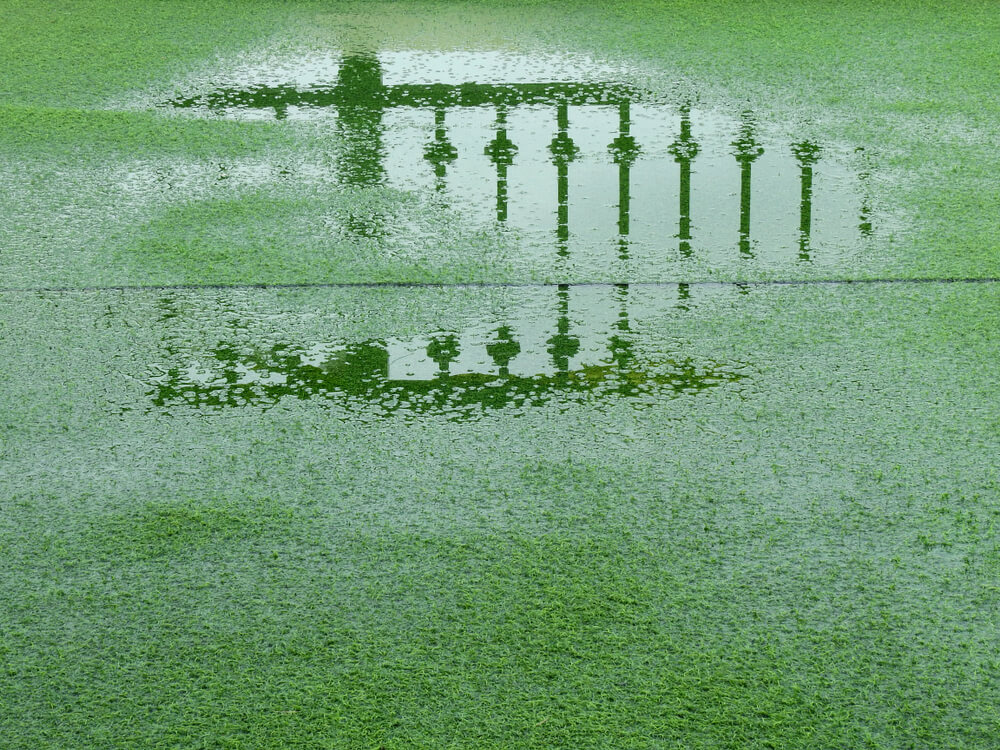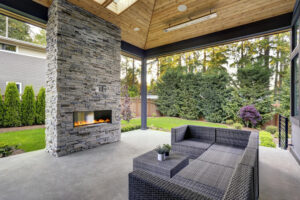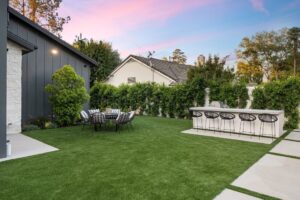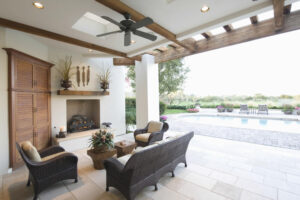Artificial turf, also commonly referred to as synthetic grass or fake grass, has gained widespread acclaim for its versatility, low-maintenance appeal, and environmentally friendly attributes. It presents an excellent alternative to natural grass lawns, particularly in regions facing water shortages or climates with extreme temperature variations.
However, many homeowners and businesses are naturally curious about how well artificial turf fares in the face of water, be it from natural rain or irrigation systems. The concern arises from the desire for their lush, green synthetic lawns to remain as vibrant as the day they were installed, regardless of the weather conditions.
So, can artificial grass get wet? Does artificial grass drain water? In this article, the team at Cricket Pavers brings you everything you need to know about artificial grass water drainage and more.
A Comprehensive Look at Artificial Turf Composition: Does Artificial Grass Drain Water?

To comprehend the waterproof qualities of artificial turf, we must first delve into the composition of this remarkable landscaping solution. Artificial turf comprises several distinct layers, each serving a specific function:
- Backing Material: At its core, artificial turf features a backing material, typically constructed from latex or polyurethane. This layer provides the foundational support that ensures the synthetic grass maintains its structure and stability.
- Drainage Holes: Scattered strategically throughout the backing, drainage holes serve as a fundamental component of the design, allowing efficient water passage.
- Infill: The infill, comprised of materials like sand or rubber granules, is evenly distributed among the blades of the synthetic grass. Its primary role is to provide support and resilience, ensuring that the artificial turf retains its shape and withstands wear and tear.
- Blades: The synthetic grass blades, constructed from materials such as polyethylene or polypropylene, are designed to replicate the look and feel of natural grass, giving artificial turf its lush, lifelike appearance.
The Water-Resistant Attributes of Artificial Turf: Can Artificial Turf Get Wet?
Artificial turf, while not inherently waterproof in the conventional sense, is explicitly engineered to be remarkably water-resistant. The crux of its water resistance lies in its sophisticated drainage system and permeable base.
Efficient Drainage System
The drainage system integrated into artificial turf is a cornerstone of its water-resistant design. When it rains or when you water your synthetic lawn, water flows swiftly through the strategically positioned drainage holes in the backing. This efficient drainage process ensures that water does not accumulate on the surface of the artificial turf, thus mitigating the risk of standing water or flooding.
This efficient drainage is especially crucial in regions that experience frequent or heavy rainfall, where the well-designed artificial turf ensures that water does not linger on the surface, making the lawn usable even during or immediately following substantial downpours.
Permeable Base
The sublayer or base upon which artificial turf is installed plays an equally pivotal role in maintaining the water resistance of your synthetic lawn. This base is typically composed of materials like crushed stone or specialized drainage materials that facilitate water movement. The permeable nature of the base prevents water from becoming trapped beneath the turf, further solidifying the overall water resistance of the installation.
The well-designed permeable base not only aids in efficient water drainage but also helps in preventing issues like soil erosion and the development of unpleasant odors that can sometimes arise in areas with poor drainage. Its composition ensures that water flows through the layers, keeping the synthetic grass above fresh and dry even in challenging weather conditions. This means that your artificial turf remains a reliable and visually appealing landscaping solution, offering enduring water resistance and aesthetics.
Prudent Maintenance and Water Management
Although artificial turf is renowned for its water-resistant attributes, it does necessitate regular maintenance and sensible water management to ensure it retains its pristine condition.
Regular Artificial Grass Water Drainage Inspection
It is essential to periodically inspect the drainage holes in the backing of your artificial turf to ensure that they remain free of debris and are not obstructed in any way. If you encounter any blockages, clear them immediately to maintain the efficient flow of water.
Avoid Overwatering
While it is vital to rinse and occasionally clean your artificial turf, it is equally important not to overwater. Excessive watering can lead to complications, such as promoting weed growth or washing away the infill material. Adhere to a reasonable and balanced watering schedule to ensure that your synthetic lawn retains its water resistance.
Balancing proper watering with occasional cleaning is key to maintaining the health and aesthetics of your artificial turf. Overwatering not only encourages weed growth but can also disrupt the stability provided by the infill material. By adhering to a measured and sensible watering routine, you ensure that your synthetic lawn retains its water resistance while minimizing potential issues, offering you a consistently beautiful and low-maintenance outdoor space.
Maintain the Permeable Base
Regularly examine the base material beneath your artificial turf. If it becomes compacted or damaged, it can impact the efficiency of water drainage. Replenish or replace the base material as required to maintain proper drainage throughout your artificial grass installation.
By routinely inspecting the base material beneath your artificial turf, you proactively safeguard the drainage efficiency of your synthetic lawn. Compacted or damaged base material can impede water flow, potentially leading to water pooling issues. To maintain optimal drainage and preserve the longevity of your artificial grass, it’s essential to replenish or replace the base material as needed, ensuring that your landscaping investment continues to serve you well.
Promptly Address Standing Water
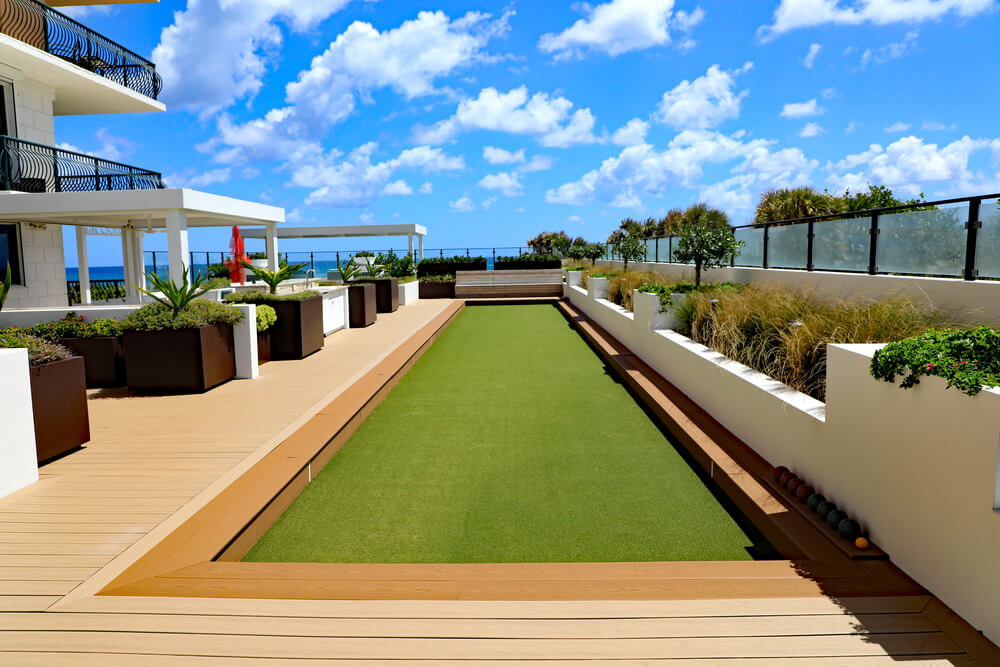
While it is a rare occurrence, if you happen to notice water pooling on your artificial turf, address it promptly. Although artificial turf can manage water efficiently, persistent standing water can potentially damage the backing and lead to issues such as mold or mildew growth. Investigate and resolve any drainage issues to ensure that your artificial turf continues to perform optimally.
Timely attention to standing water issues on your artificial turf is essential to prevent potential damage. Standing water can compromise the backing of your synthetic grass, affecting its long-term durability and appearance. By promptly investigating and resolving any drainage problems, you’ll ensure that your artificial turf remains in top condition, maintaining its resilience and beauty, even in the face of uncommon water-related challenges.
So, Is Artificial Grass Waterproof?
Artificial turf is a water-resistant landscaping solution that is well-suited for use in regions with diverse climates and weather patterns. Its advanced drainage system and permeable base make it resilient in the face of both rain and irrigation. With proper maintenance and sensible water management, you can keep your artificial turf in excellent condition and revel in the advantages of a lush, low-maintenance lawn, regardless of the weather conditions. Artificial turf continues to shine, whether the sun is beaming down or the rain is falling, and with a little care, it will maintain its brilliance year after year. So, you can rest assured that your synthetic lawn will remain evergreen, no matter the weather.
That said, if you have any further questions, feel free to reach out and ask away.
